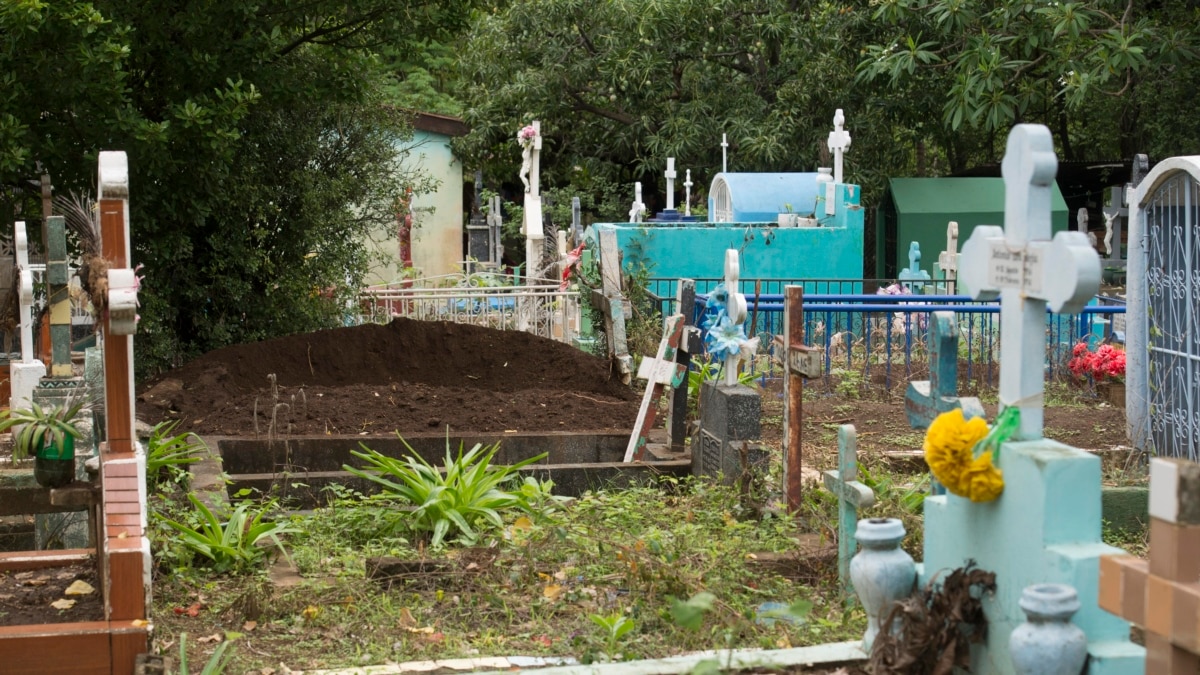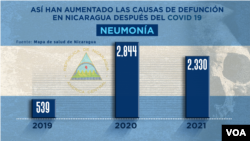The number of Nicaraguans who die from heart attacks, diabetes and pneumonia began to rise as a result of the pandemic that arrived in the country in 2020, according to data of the Ministry of Health.
For example, in 2018, 3,168 people died of heart attacks, and in 2019, 3,097. However, in 2020 some 5,164 people died from this cause, almost double the previous year, and in 2021 the figure was 6,481 deaths from heart attacks, more than double that of 2019.
From January to June 2022, at least 2,550 people died from the same cause.
The same happened with diabetes, which almost doubled from 3.5% per 10,000 inhabitants in 2019 (2,253 deaths), to 6.3% in 2020 (4,132 deaths).
In the case of pneumonia, it went from being the ninth cause of death for Nicaraguans in 2018 to number four in 2020.
In 2019, 539 people died of pneumonia, and the number increased to 2,844 in 2020.
Epidemiologist Leonel Argüello, founder of the Ministry of Health in Nicaragua and who has studied the behavior of diseases and the causes of death in the country for years, said that it is difficult to establish a relationship between the increases and the pandemic, because in Nicaragua there are “a bias”, on the diagnoses “product of the concealment of figures during the pandemic”.
The lack of data also prevents establishing an epidemiological characterization, he explained. “Who gets that heart attack, at what time, in what place or conditions, what he did immediately before he gave him the heart attack are important data to have an epidemiological characterization,” Argüello said.
Donald Moncada, an expert who is part of the Nicaraguan Medical Unit, tells the VOA that this phenomenon that is observed in mortality statistics in Nicaragua has been studied by specialist epidemiologists.
Moncada mentions that there is a study used by the World Health Organization (WHO) called the “Excess Mortality Study” and it has been used to effectively determine the number of deaths from COVID or related to COVID in the countries. in which the statistical information is not very reliable.
In his opinion, in countries like Nicaragua where this phenomenon of excess mortality has been seen in some diseases: pneumonia, hypertension, diabetes, acute myocardial infarction, these four are the main ones, they are the ones that have grown more than normal and are analyzed the previous years without a pandemic and then the mortality in the years during the pandemic, 2020 to 2022, and there the number of deaths is compared.
“In the case of Nicaragua, it seems that the government wanted to hide the mortality figures, so instead of saying that the person died of COVID, they said that he died of non-specific pneumonia, or that he died of a heart attack, or that he died of hypertension. or diabetes.”
And the current deaths, according to the Nicaraguan specialist, is “another phenomenon” associated with COVID in what is known as the post-COVID syndrome, or the COVID that has prevailed; even though you no longer show all the symptoms of COVID, some people who had COVID infection persist.
Argüello, for his part, indicates that COVID-19 can damage the heart and the rise in cases of heart attacks in Nicaragua could be a consequence of the pandemic, but information on the deceased is unknown, which is essential to establish a relationship, such as demographics or history of the patient.
For Argüello, delving into these factors is key to knowing if COVID-19 could be a cause of the increases in deaths.
“If you ask the population on the streets, they don’t know what Nicaraguans are dying of. They can tell you about cancer, about this, about that, but they have no idea what the first cause is. That shows you that there is no health education and that people whose deaths could have been foreseen are dying. That is one of the elements that must be taken into consideration”, pointed out Argüello.
Lack of education and information, say experts
At a general level, in 2018 24,296 people died in Nicaragua, which represents a mortality rate of 37.6 per 10,000 inhabitants, and in 2020 33,650 people died, a mortality rate of 51 per 10,000 inhabitants.
The responsibility of reducing these death figures, according to Dr. Argüello, falls on the government, mainly on the health and education authorities.
“It is much more expensive for the government to care for a patient who has cancer than to promote prevention. We are a country that should be doing a lot of prevention. For example, people should be educated to know what corresponds to them and that has not been done because things have become politicized.”
“You have to make an investment in health,” concluded Argüello.
The Nicaraguan government has registered 15,569 Covid19 infections from the start of the pandemic until January 2022, a figure that independent experts and organizations have indicated as suspiciously low.
The map of chronic diseases and deaths in Nicaragua has not been updated since June 2022.
Connect with the Voice of America! Subscribe to our channel Youtube and activate notifications, or follow us on social networks: Facebook , Twitter and instagram .



















